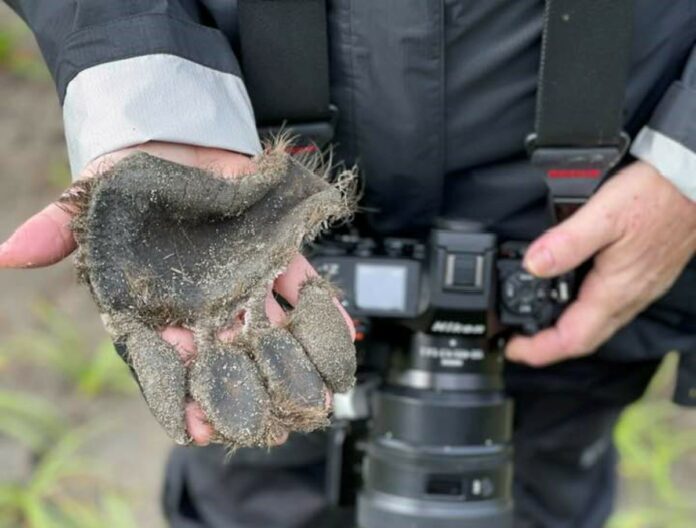While trekking along Tuxedni Bay in Lake Clark, Alaska, photographer Molly Thomas came across something unusual.
Lying on the ground in front of her was a discarded bear paw pad, a little larger than a human hand. “[It] kind of looked like an old glove,” Thomas told Newsweek.
Molly Thomas/Facebook
Thomas, a wildlife photographer from Dayton, Ohio, had gone to Alaska to photograph bears. She knew immediately what she had found.
“The paw had a strong odor,” Thomas said. “There were bear hairs attached to the perimeter of the pad, [and it was] leathery to the touch.”
Brown bears can be found throughout most of Alaska. They are slightly larger than the black bears found throughout most of the U.S., growing to between 3 and 5 feet on all fours. Black bears, meanwhile, rarely make it above 3.5 feet, according to the National Park Service.
The Alaska Department of Fish and Game says that there are roughly 30,000 brown bears across the state. Although they are generally solitary creatures, they will often gather in large groups at concentrated feeding sites like salmon spawning streams.
Bears shed the skin on their footpads every year, usually during hibernation, per the charity Appalachian Bear Rescue. “When they emerge from their dens in the spring, they have ‘new shoes’,” the charity said in a Facebook post about the behavior.
“The skin on their feet toughens and crack over the year. They shed the skin to reveal new skin.”
Thomas gave the paw pad to a local bear guide who was intrigued by the discovery. “He had never seen one before, and I think he will share with other guests,” Thomas said.
Thomas took a photograph of the bear paw and shared it to her Facebook and Instagram (@mojothomas).
“Amazing you found this! Fantastic find/image. Your photos are awesome!” commented one user.
“I keep showing my friends because no one believes me that they shed these!!!” wrote another.
If you ever encounter a bear in the wild, remain calm and keep your distance, the National Park Service says. Pick up small children, but do not run, climb a tree or allow the bear to access your food.
Bear attacks are extremely rare, although the parks service does have recommendations for what to do in these unusual circumstances. When facing an attack by a brown bear, it is best to play dead: Lie flat on your stomach with your hands clasped behind your head. Only if the bear continues to attack should you attempt to fight back.
Black bears are the opposite: You should never play dead around a black bear. Your first move is to try to escape, but if that is not possible, you should fight back by targeting the animal’s face and muzzle.


